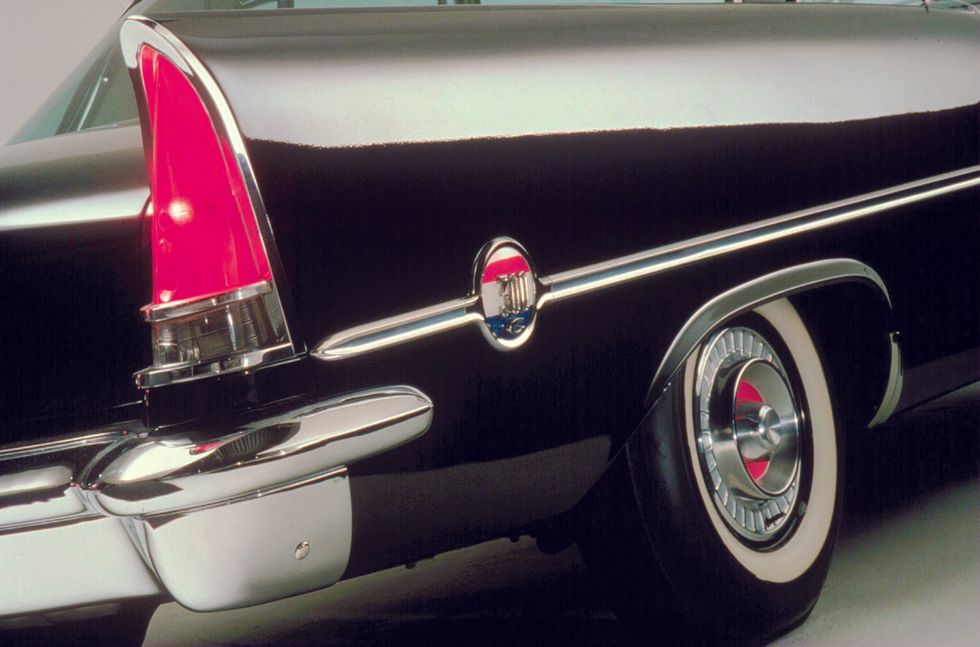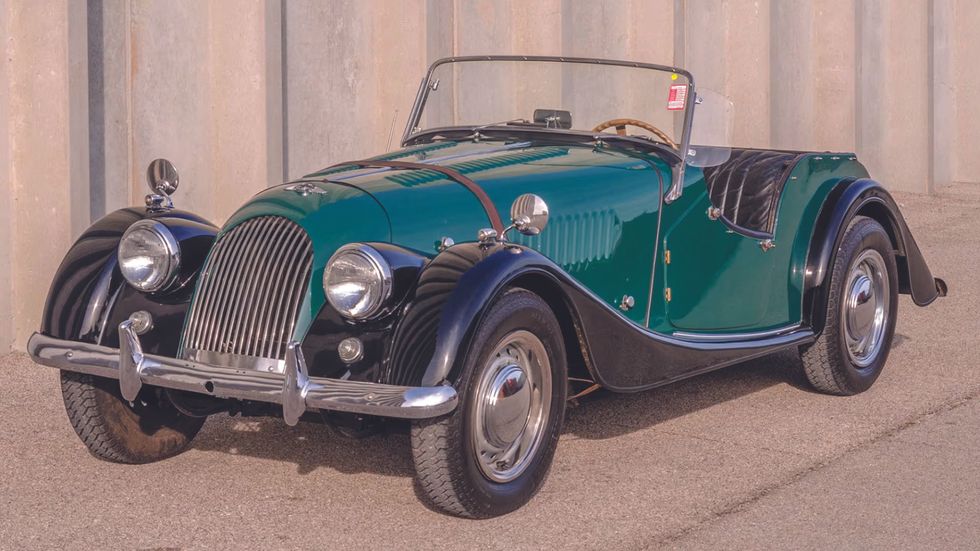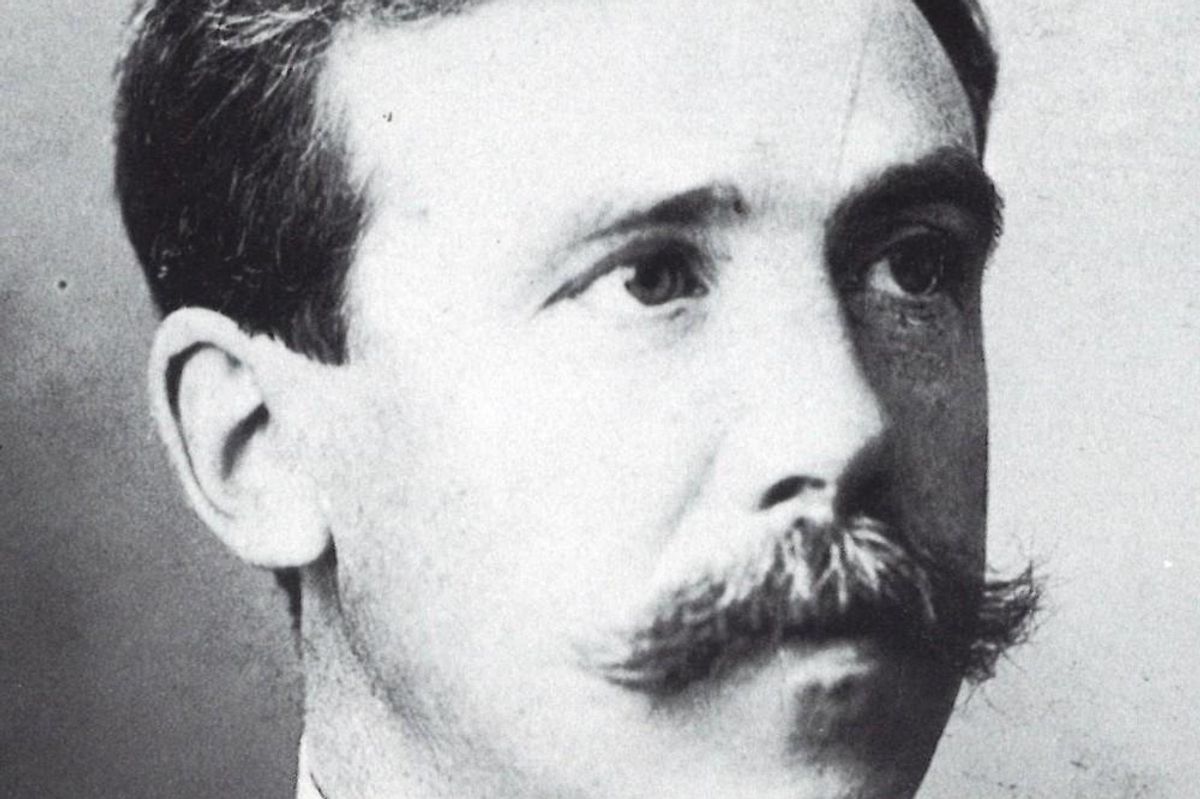Buy
Resources
Entertainment
Magazine
Community
In This Article
Category:
Classics
WE'VE WRITTEN ANY NUMBER OF times in these pages about one Scotsman who came to America, got involved in the world of automobiles, and eventually faded into obscurity. We're talking specifically about David Dunbar Buick, a man who died leaving little more than his name to the car he founded. A happier tale exists with the biography of Alexander Winton, born in 1860 on the banks of the Strathclyde, who came to America at the age of 19 to seek his fortune. As leading lights of the car industry go, he's not well known. Too bad, because for all his faded memory, the guy lived a productive, fascinating life.
Winton arrived in New York City in 1879, where he shortly found employment as an ironworker before signing on with a steamship line as an assistant engineer. Five years on the bounding main brought him back to dry land, and Winton moved to Cleveland, where his sister lived. There, he and his brother-in-law did what so many other early car guys did, which was to open a bicycle shop. It was a success, but being the 1890s, it was natural for Winton to explore the possibilities of vehicles propelled by something other than muscle power.
His first experimental powered car, with a single-cylinder engine and seats for four, rolled out in 1896. The next prototype, which appeared the following year, could seat six. Winton bought an excessed Cleveland factory to manufacture his cars, while staying in the cycle business until at least 1899. During that period, Winton built what are believed to have been the first gasoline-powered trucks produced in the United States. Also, a Winton became the first car of any sort to cross the country, coast to coast.
By 1900, the Winton Motor Carriage Company was also the largest purveyor of gasoline-engine automobiles in this country, with more than 100 units produced, including one sold to James Ward Packard, who was so annoyed with its performance that he went into building cars himself. Winton decided that the way to get still bigger was to go racing, which is arguably his most enduring claim to automotive fame. In 1901, Winton took his stripped-down beast, the Winton Bullet, to Detroit for a match race against the 999, piloted by an unknown named Henry Ford, and fell out while leading. That was in 1901, and it allowed Ford to lure investors who financed his new Ford Motor Company. Winton lost another round to the 999 shortly thereafter, this time with the immortal Barney Oldfield in the saddle. One year, in an early Gordon Bennett race, Winton entered a single-cylinder race car whose engine displaced 3.8 liters. It broke.
Things went better on the road-car side, with Winton introducing its first straight-six engine in 1908, boasting a price that pushed $6,000. Still, more than 1,200 found buyers. Winton next moved to downsize his cars and engines while expanding their range of body styles. The outlook was initially positive, but sales dropped to only a few more than 100 units in 1924, when auto sales ceased. By then, Winton was well involved in the production and design of large marine and stationary diesel engines, which burned "distillate," as the heavy fuel oil was then called. General Motors bought the operation in 1930, two years before Winton died, and installed a distillate Winton V-12 in the M-10000, the first lightweight, streamlined passenger train ever built. Winton was absorbed into GM's Electro-Motive Corporation, later Electro-Motive Division, which produced heavy rail locomotives until GM sold it to Caterpillar in 2005.
Recent
Photo: Stellantis
For nearly 70 years, Chrysler’s Letter Cars have represented a high point of American automotive design with their muscular V-8 engines, taut handling, luxurious interiors, and head-turning styling. Of these, the hemi-powered 1957 300C two-door hardtop and convertible remain in high demand. That’s evident in their book values, even if auction results tell a different tale.
Chrysler electrified the automotive marketplace in 1955 with its race-proven, 300-hp V-8-powered C-300 and followed that with the 355-hp 300B. For 1957, Highland Park would introduce America’s most powerful eight-cylinder engine since the supercharged Duesenberg SJ: the twin-four-barrel-carbureted FirePower 392-cu.in. hemi V-8 under the hood of the new 300C made 375 hp in standard form or 390 in competition tune. The new TorsionAire front suspension brought fine road manners, while the car’s bold “Forward Look” styling with quad headlamps and sweeping tailfins made both body styles real head turners. While this model sold better than its predecessors, it was still expensive and exclusive: 1,767 of the $4,235 ($46,275 in today’s dollars) hardtops were sold, along with 484 of the $4,390 ($47,970) convertibles.

Rob Kern, 1957 300C advisor for the Chrysler 300 Club International (chrysler300club.com), tells us this model and the similar 1958 300D are among the most-sought Letter Cars due to their innovations and styling. “This was very significant, being the first convertible and introducing features that went away after the 300D,” he explains. “The values of top-condition 300C coupes are in the range of $85,000 to $90,000, while convertibles–even those needing total restoration–can command much more. While prices spiked between 2005 and 2015, they now seem to have stabilized. Of course, this depends on how special a car is and if it has an award-winning restoration, because body rust, parts availability, and finding specialist help are challenging. The 300C still represents a pretty good value for what it is, and this model is popular with younger members new to the club.”

The Classic Car Price Guide under the Resources tab on Hemmings.com turns up 17 ads from the past three years; the average asking price in those ads was $71,605.88, with $28,950 at the low end and $195,000 at the high. Those numbers largely correlate with traditional value guides covering the marketplace of these 300Cs; J.D. Power now suggests a hardtop should retail between $17,700 and $76,500, and a convertible can command between $39,900 and $119,800.
Turning to auctions, 10 hardtops have sold in the past five years with prices ranging between $18,700 and $63,000; the latter traded hands through Hemmings Auctions in March 2022. According to classic.com, the hardtop has an average sale value of $45,622, and is considered a rising Classic Market Benchmark at $45,602. The lower-production convertible is also considered a rising Classic Market Benchmark (at $123,229), with an average sale figure of $101,267. Just three soft-tops have sold since 2019: an unrestored example brought $47,300 in 2022, while two restored cars brought $86,000 and $170,500 in 2020 and 2023.
Keep reading...Show Less
Photo: Mecum Auctions
Whether you’re into prewar classics, 1950s cruisers, ’90s family haulers, or the future collectibles of today, Mecum Auctions has you covered. The respected auction house brought a smorgasbord of choice to its popular Kansas City event at the Missouri’s Kansas City Convention Center, November 30 through December 2.
There were 700 vehicles offered, along with 256 items of “Road Art” automobilia; after the final tallies were made, Mecum reported a 74-percent sell-through rate and $16.3 million in sales. The number-one earner was a 5,154-mile 2005 Ford GT that brought $429,000; following it in the top three were a Super Cobra Jet-powered 1970 Shelby GT500 convertible ($286,000) and a 19-mile 2023 Dodge Challenger SRT Demon 170 ($214,500). Additionally, two collections were offered to bidders at no reserve: the 16 special vehicles from the Jim Blin’s Cars of Yesteryear at Heartland Acres Collection crossed the block for a total take of $818,430, while the 14-vehicle John Hollansworth Sr. Collection similarly sold all for $296,210.
The 2023 Kansas City event proved a healthy bump over the 2022 edition, having brought in an additional $1.4 million and maintained the same sell-through rate despite one fewer vehicle lot; the 2023 top sale handily outpaced the 2022 top sale (earning an additional $176,000) as well. After April’s Houston event, Mecum Auctions will host another 10 auctions in 2024, the final being Kansas City.
By The Numbers

This extremely tidy 1994 Ford Explorer Limited showed only 18,207 miles on the odometer and found a new home for $4,400, a veritable steal for the SUV that changed the buying habits of American families.
Photo: Mecum Auctions
- Total Sales: $16.3 million
- Sell-Through: 74 percent
- Average Automotive Sale: $26,210
- Top Sale: 2005 Ford GT, $429,000
Legend

This 1971 Lincoln Continental Mark III sported 30,062 miles on the odometer and found a new home for $18,150.
Photo: Mecum Auctions
- Condition: #1=Excellent; #2=Very Good; #3=Average; #4=Poor; #5=Major Project
- Reserve: Minimum price owner will accept
- High Bid: The highest offer made (but the vehicle did not sell)*
- Selling Price: What the vehicle sold for*
- Average Selling Price: Average market value of vehicles in similar condition
*Prices shown for sold automotive lots include the buyer's premium of 10-12%. Non-motorcar sales incurred an 18-20% buyer's premium.
1967 Kaiser-Jeep Jeepster Commando

Photo: Mecum Auctions
- Condition: Restored/#2
- Reserve: Undisclosed
- Selling price: $37,400
- Avg. selling price: $25,049
With all the hype over early SUVs in today’s collector-car market, it wasn’t surprising to see this restored first-year Jeepster Commando bring a good sum. It was a real looker with the coordinating hard roof and striping over shiny paint, with fresh chrome, vinyl seat upholstery, and carpeting. New weatherstripping, spray-on bedliner, and tires were also noted. The instrument cluster exhibited wear and overspray, but the 225-cu.in. V-6 engine, mated to a three-speed manual, was tidy. Classic.com noted that, after it was sold at this auction, the Jeepster was resold by a dealer with a $37,900 asking price.
1991 Pontiac Grand Am

Photo: Mecum Auctions
- Condition: Original/#2
- Reserve: Undisclosed
- Selling Price $18,150
- Avg. selling price: $2,025
What’s a run-of-the-mill car like this ’91 Grand Am doing in a collector-car auction? The once-ubiquitous model was noteworthy for being a little-used (17,265 miles), well-kept survivor equipped with a four-cylinder/automatic powertrain, A/C, and a cassette stereo. It presented as nearly new, despite being 33 years old. This Pontiac was no stranger to Mecum’s auctions, though, having sold for $16,500 at Indianapolis in May 2022, and failing to sell in two additional 2022/2023 Mecum auctions before this one. Excluding fees, it brought the same price twice… leagues above its retail book value.
1930 Chrysler 77

Photo: Mecum Auctions
- Condition: Restored/#3
- Reserve: Undisclosed
- Selling price: $71,500
- Avg. selling price: $53,780
Chrysler’s 1930 “77” was its top six-cylinder model that year, and the low-production roadster, with rumble seat, golf-bag door, and accessory trunk, was the sportiest variant. This driven example had an older restoration and appeared very well maintained, although age was evident in some chrome trim, lightly creased seat leather, and the notably worn steering wheel finish. The 268-cu.in., 93-hp inline-six and undercarriage were tidy, and the dashboard was autographed by Jay Leno. J.D. Power suggests a retail value range of $19,100 to $50,700 for the 77 roadster, which this car handily exceeded.
1973 Ford Mustang

Photo: Mecum Auctions
- Condition: Original/#2+
- Reserve: Undisclosed
- Selling price: $57,200
- Avg. selling price: $25,590
If you couldn’t tell by the final price, there was more to this Mustang than met the eye. It was a never-titled car, still on its Manufacturer’s Statement of Origin, that was owned since new by a Ford dealership, had 2,147 miles on its odometer, and came with its original paperwork. This final first-gen convertible was moved by a 154-hp, two-barrel 351 Cleveland V-8/Select-Shift Cruise-O-Matic, and among $1,391.81 in options ($9,625 in today’s money!) were A/C and numerous power goodies. The factory tires were replaced with radials and minor storage wear was evident. This result was no surprise.
1949 Frazier Manhattan

Photo: Mecum Auctions
- Condition: Restored/#2-
- Reserve: Undisclosed
- Selling price: $24,200
- Avg. selling price: $14,000
The ground-up restoration performed by a Kaiser/Frazer specialist on this ’49 Manhattan that incorporated NOS parts was key to its fine performance on the block at Mecum. The demure sedan, rolling on wide-whitewall bias plies, appeared in great condition with nice chrome and stainless trim, shiny maroon paint, rich cloth upholstery, and only minor chips and scuffs visible on some under-hood components. The 226.2-cu.in. flathead inline-six was mated to the three-speed manual transmission with optional overdrive. This Independent soundly trounced its auction-sale average and average retail book value.
1985 Porsche 911 Carrera

Photo: Mecum Auctions
- Condition: Original/#2-
- Reserve: Undisclosed
- Selling price: $63,800
- Avg. selling price: $42,690
It was in no way surprising to see this one-owner, 73,189-mile Carrera Cabriolet cause a real stir when it crossed Mecum’s block. It ticked all the right boxes: documentation back to new, iconic Guards Red paint, optional forged Fuchs alloys mounting new Michelins, power-adjustable partial-leather sport seats, and recent major service on the 200-hp 3.2-liter boxer engine. It presented handsomely with minor creasing on the seats and a section of crumbling door weatherstripping as visible flaws. This air-cooled 911 easily beat the average auction sale price as well as the average retail book value.
1954 Chevrolet Corvette

Photo: Mecum Auctions
- Condition: Restored/#2-
- Reserve: None
- Selling price: $110,000
- Avg. selling price: $80,450
This Corvette from the Jim Blin’s Cars of Yesteryear at Heartland Acres Collection ended up the eighth-highest sale of this auction. It was Bloomington Gold Certified in 1993, proving it was accurately restored, and remained attractive 30 years on. The Sportsman Red paint beckoned onlookers to appreciate the clean engine bay and color-matched interior, the latter only let down by failing stitching on the driver’s seat bottom. While the ’Vette wore radial tires, it came with a second set of correct wheels mounting bias-ply tires for show duty. With no reserve, it fired up the bidders to a good result.
1991 Dodge Ramcharger

Photo: Mecum Auctions
- Condition: Original/#3+
- Reserve: Undisclosed
- Selling price: $19,800
- Avg. selling price: $16,250
The original window sticker, still present with this Ramcharger LE, tells us that, when new, the full-size SUV cost the equivalent of nearly $52,000 in today’s money. It was well equipped with the 5.9-liter V-8, four-wheel drive, automatic transmission, A/C, and an AM/FM stereo cassette. The Dodge remained in excellent condition considering its 99,159 miles, with only minor rust bubbling visible in the rear-hatch jambs and a bit of surface corrosion on a few engine components. The two-tone paint kept a nice shine and the velour-upholstered interior looked fresh. This Ramcharger should only increase in value.
1960 Morgan Plus 4

Photo: Mecum Auctions
- Condition: Restored/#3
- Reserve: Undisclosed
- Selling price: $26,400
- Avg. selling price: $27,500
While all classic British sports cars are desirable, classically styled Morgans have a unique appeal. This U.S.-spec Plus 4 was in fine shape, looking sharp with two-tone paint, radials on steel wheels (the spare wore a bias-ply) and a leather bonnet strap. The leather interior had a warm patina, a tonneau and top were present, and the twin-carb 2.0-liter engine enjoyed Lawrence Tune fettling. This model was another instance where the value guides and auction results differed substantially, in this case with actual sales being in line with Mecum’s result rather than the notably higher retail value.
1981 DMC De Lorean

Photo: Mecum Auctions
- Condition: Refurbished/#3
- Reserve: Undisclosed
- Selling price: $44,000
- Avg. selling price: $57,335
This first-year, low-mileage (46,333) product of the De Lorean Motor Company was made more desirable by its five-speed manual transmission. Its famous grid-pattern taillamps were missing their orange segments and there was minor dashboard separation, but the interior looked otherwise appealing with grey velour (instead of original leather) seating surfaces, a padded glovebox lid, and an aftermarket stereo. Recent servicing of the PRV V-6 was noted. Value guides on DMCs vary: as this is written, classic.com says the average auction sale price is $57,335, while J.D. Power calls $40,000 average retail.
1971 Pontiac GTO

Photo: Mecum Auctions
- Condition: Restored/#3+
- Reserve: Undisclosed
- Selling price: $42,900
- Avg. selling price: $40,000
What a striking thing this ’71 GTO was, its glowing-sunset paint hue accented by “The Judge”-style tricolor fender decals and rear-deck airfoil. A copy of the original window sticker listed the Pontiac’s many options that included a console-shifted automatic, A/C, and power seats, windows, and locks. The Sandalwood interior was tidy, but it showed age via a cracked dash pad, worn steering wheel, and a bit of failing trim on the door panels and driver’s seat. The 255-hp 400-cu.in. V-8 was very clean. Post-1970-GTO values are softer than those of earlier models, but this was still a pretty good buy.
1929 Packard Deluxe Eight

Photo: Mecum Auctions
- Condition: Restored/#2
- Reserve: None
- Selling price: $148,500
- Avg. selling price: $147,100
Arguably the most regal car offered in Kansas City was this Packard Deluxe Eight with prestigious Dietrich dual-cowl phaeton coachwork. Coming from the Jim Blin collection and selling at no reserve, its fifth-highest-price-of-the-event result was right in line with other 1929 Deluxe Eights sold at auction in the last four years. The heavily chrome-accented car presented nicely outside and in, with minor letdowns including yellowed whitewall tires and evidence of leaks and corrosion around the 385-cu.in. straight-eight engine. This Packard undoubtedly became the centerpiece of another collection.
Keep reading...Show Less








